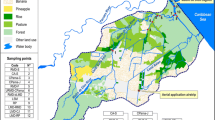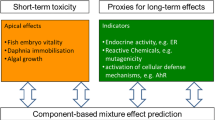Abstract
This paper illustrates the use of deterministic and probabilistic approaches to the ecotoxicological risk assessment of effluents through two simple examples taken from the UK Direct Toxicity Assessment Demonstration Programme. In this study, the direct protection objective for the River Esk in Scotland was the prevention of short-term lethal toxicity to invertebrates from exposure to effluent containing insecticides. Both a deterministic and a probabilistic risk characterisation show that such toxicity is very unlikely to occur. The protection objectives for the Lower Tees Estuary were more complex, due to a variety of discharges and potentially sensitive species. A deterministic risk assessment using the most sensitive species suggests that toxicity will be high at all times. In contrast, a probabilistic risk assessment suggests that, although acute toxicity is considerable, it is not likely to occur at all times or affect all species, and discharge scenarios do exist in which acute toxicity could be relatively low. These two case studies illustrate the use of probabilistic risk assessment in achieving more realistic assessments of effluent toxicity through use of all available data.
Similar content being viewed by others
References
BUA Project Group (1999). Assessment criteria for the marine environment. Final report, May 7, 1999.
Crane, M., Grosso, A. and Janssen, C. (2000). Statistical techniques for the ecological risk assessment of chemicals in freshwaters. In T. Sparks (ed). Statistics in Ecotoxicology, Chichester: John Wiley & Sons. pp. 247–78.
EC (1996). Technical Guidance Document in Support of Commission Directive 93/67/EEC on Risk Assessment for New Notified Substances and Commission Regulation (EC) No 1488/94 on Risk Assessment for Existing Substances. Part II Environmental Risk Assessment. Office for Official Publications of the European Community, Luxembourg.
Girling, A. (2001a). UK Direct Toxicity Assessment (DTA) Demonstration Programme: Lower Tees Estuary Project-Part I. Report 00/TX/02/03. UK Water Industry Research Ltd, London, UK.
Girling, A. (2001b). UK Direct Toxicity Assessment (DTA) Demonstration Programme: Lower Tees Estuary Project-Part II. Report 00/TX/02/04. London, UK: UK Water Industry Research Ltd.
Girling, A.E., Riddle, A.M., Mitchell, G.M., Chown, P., Tinsley, D., Buckler, C., Johnson, I. and Benstead, R. (2004). Estimating spatial patterns of effluent exposure concentrations in Direct Toxicity Assessment studies. Ecotoxicology 13, 449–61.
Grist, E.P.M., Leung, K.M.Y., Wheeler, J.R. and Crane, M. (2002). Better bootstrap estimation of hazardous concentration thresholds to protect biological assemblages. Environmental Toxicology and Chemistry 21, 1515–24.
Grist, E.P.M., Crane, M., Jones, C. and Whitehouse, P. (2003a). Estimation of demographic toxicity through the double bootstrap. Water Research,37, 618–26.
Grist, E.P.M., Wells, N.C., Whitehouse, P., Brighty, G. and Crane, M. (2003b). Estimating the effects of 17Bethinylestradiol on populations of the fathead minnow Pimephales promelas: are conventional toxicological endpoints adequate?
Hart, A. (2001). Probabilistic Risk Assessment for Pesticides in Europe. Implementation and Needs. Report from the European Workshop on Probabilistic Risk Assessment for the Environmental Impacts of Plant Protection Products, The Netherlands, June 2001. Central Science Laboratory, York, UK.
Hutchings, M., Johnson, I., Hayes, E., Girling, A.E., Thain, J., Thomas, K., Benstead, R., Whale, G., Wordon, J., Maddox, R. and Chown, P. (2004). Toxicity Reduction Evaluation, Toxicity Identification Evaluation and Toxicity Tracking in Direct Toxicity Assessment. Ecotoxicology 13,475–84.
Johnson, I. (2001). UK Direct Toxicity Assessment (DTA) Demonstration Programme: River Esk Project. Report 00/TX/02/02. UK Water Industry Research, London, UK.
Johnson, I., Hutchings, M., Benstead, R., Thain, J. and Whithouse, P. (2004). Bioassay selection, Experimental Design and Quality Control, Assurance for use in Effluent Assessment and Control. Ecotoxicology 13, 437–47.
Maltby, L. and Calow, P. (1989). The application of bioassay in the resolution of environmental problems: past, present and future. Hydrobiologia 188/189, 65–76.
Power, E.A. and Boumphrey, R.S. (2004). International trends in bioassay use for effluent management. Ecotoxicology 13, 377–98.
en.html}.
Suter, G.W. II. (1995). Introduction to ecological risk assessment for aquatic toxic effects. In, G.M. Rand (ed). Fundamentals of Aquatic Toxicology: Effects, Environmental Fate and Risk Assessment, pp. 803–16. Washington, D.C.: Taylor & Francis.
Tinsley, D., Wharfe, J.R., Campbell, D., Chown, P., Taylor, D., Upton, J.and Taylor, C. (2004). The use of Direct Toxicity Assessment in the Assessment and Control of Complex Effluents in the UK: A Demonstration Programme. Ecotoxicology. 13, 423–36.
Wharfe, J. (2004). Hazardous Chemicals in Complex mixtures-A Role for Direct Toxicity Assessment. Ecotoxicology 13, 413–21.
Wharfe, J., Tinsley, D. and Crane, M. (2004). Managing Complex mixtures of Chemicals-A Forward Look from the Regulators' Perspectrive. Ecotoxicology 13, 485–92.
Whitehouse, P. and Cartwright, N. (1998) Standards for environmental protection. In P.E.T. Douben (ed). Pollution Risk Assessment and Management: A Structured Approach. pp. 235–72. Chichester: Wiley.
Whitehouse, P., Johnson, I., Forrow, D. and Chubb, C. (2004). A Regulatory Framework for Controlling Effluent Discharges using Toxicity Testing in the UK. Ecotoxicology 13, 399–412.
Author information
Authors and Affiliations
Rights and permissions
About this article
Cite this article
Crane, M., Grosso, A., Whitehouse, P. et al. Risk Characterisation in Direct Toxicity Assessment of The River Esk and The Tees Estuary. Ecotoxicology 13, 463–474 (2004). https://doi.org/10.1023/B:ECTX.0000035296.35195.ff
Issue Date:
DOI: https://doi.org/10.1023/B:ECTX.0000035296.35195.ff




